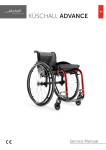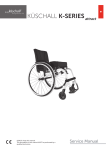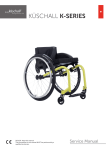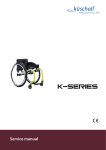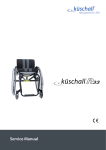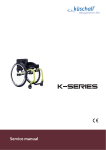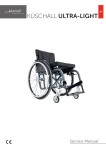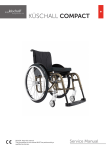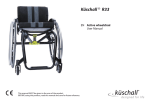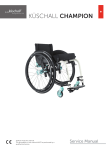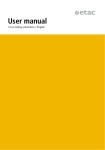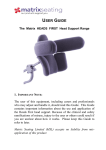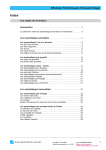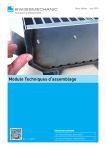Download Kuschall Advance Service Manual 0515
Transcript
KÜSCHALL ADVANCE DEALER: Keep this manual. The procedures in this manual MUST be performed by a qualified technician. Service Manual Service Manual KÜSCHALL ADVANCE TABLE OF CONTENTS GENERAL....................................................................................................................... 4 Introduction 4 Spare parts and adaptations 4 Tightening Allen screws 4 Torque 5 Checks 5 Identifying and alleviating malfunctions 5 OVERVIEW.....................................................................................................................6 Seat width (SB) 6 Seat depth (ST) 6 Front seat height (SHv) 6 Rear seat height (SHh) 6 Seat angle (SW) 6 Backrest height (RH) 7 Backrest angle (RW) 7 Lower leg length (UL) 7 FRAME............................................................................................................................ 8 Mounting frames and seat plates 8 Attaching the quick release frame to the seat plate 10 BACKREST....................................................................................................................11 Adjusting the backrest height 12 Setting the backrest angle 12 Adjusting the backrest joint 13 Replacing the backrest tube 13 Replacing the handle 14 Replacing foldable push handles 14 FOOTRESTS.................................................................................................................15 Install / replace footrest and adjust height 15 Assembling the foot plate cover 16 Replacing the footplate support 16 Fitting and adjusting high-mounted footrest 17 Attaching the forward footrest 17 Angle-adjustable footplate, adjusting the angle 17 Fitting the fold-up footrest 18 SIDE PARTS..................................................................................................................19 Armrest / Siderest 19 Clothes-guard / mudguard 20 FRONT WHEELS......................................................................................................... 22 Replacing a front wheel 22 Replacing a front wheel fork 22 Checking and adjusting the castor angle 23 Checking and adjusting the drift angle 23 Shift supporter on the frame 24 REAR WHEELS............................................................................................................ 25 Attach vertical brace to the seat plate 25 Changing the wheel chamber / Fitting and adjusting an axle 25 Ensuring the rear wheels are parallel 29 Adjusting the removable axle 29 2 © Küschall AG, Switzerland | 2015-09 Service Manual KÜSCHALL ADVANCE BRAKES........................................................................................................................ 30 Positioning the parking brake 30 Fitting / adjusting the parking brake 30 OPTIONS & ACCESSORIES........................................................................................31 Antitipper 31 Active antitipper 32 Transit wheels 32 Fitting the pelvic belt 33 3 © Küschall AG, Switzerland | 2015-09 Service Manual KÜSCHALL ADVANCE GENERAL Introduction This service manual is part of the instructions and contains the technical information for servicing, configuring and repairing a küschall® wheelchair. WARNING! Danger of accident and severe injuries. If the wheelchair is improperly set it can cause accidents and severe injuries. ▸▸Changes to the wheelchair may only be carried out by the provider. To guarantee the required safety and reliability, all wheelchairs must be comprehensively checked once a year. In part, assembly and adjustment require extensive experience. For this reason, the following assembly instructions have been split into three categories: Requirement Symbol Easy – technical understanding required Intermediate – specialist knowledge required Difficult – specialist wheelchair assembly knowledge and experience required The required tools and their respective sizes are listed above each instruction. The instructions include information on the torques with which the respective screw connections must be tightened. Adhering to the given torques requires the use of a torque spanner. Tools Symbol Allen key à 3, 4, 5 Hexalobular key (Torx ) ® Phillips screwdriver T15 Ò2 Straddle spanner Socket spanner/ring spanner 10, 11, 19 8, 10 Spare parts and adaptations All spare parts can be purchased from küschall® Customer Services. An electronic spare parts catalog is available by logging onto www.kuschall.com. Only original spare parts may be used. Installing additional adaptations to a küschall® wheelchair requires the prior written approval of Küschall AG. Tightening Allen screws Allen keys are not designed for greater forces. When tightening or loosening an Allen screw, it is therefore advisable to apply force to the nut to prevent the hexagon socket from being damaged. Tightening and loosening Turn the nut with a socket spanner (only use a straddle spanner if there is insufficient space) and merely hold the screw tight with the Allen key. 4 © Küschall AG, Switzerland | 2015-09 Service Manual KÜSCHALL ADVANCE Tightening and loosening if there is no nut If an Allen screw is directly screwed into a screw thread, the screw must be tightened using an Allen key. i and not worn. Ensure that the Allen key is of good quality Torque All screw connections must be tightened with the torques specified in the following instructions. Checks Visual check Check all components for cracks, especially the areas around joints and welded seams. Checking the screw connections Check all bolts with the torques specified in the instructions regularly, and adjust if required. CAUTION! Several screw connections have been secured with thread locking adhesive. If these are opened, they must be secured again using new thread locking adhesive. Liquid high-strength and low-strength adhesives are available. For torque entries notice shall be made whether an adhesive and which adhesive needs to be used. Identifying and alleviating malfunctions Malfunction The wheelchair will not move in a straight line The wheelchair tips backwards too easily The brakes engage poorly or asymmetrically Roll resistance is too great The front wheels wobble when moving fast The front wheel is stiff or stuck Increased forward tip tendency Possible cause Frames are not parallel Frames and/or supporters are not vertical to the ground Alignment of the supporters is incorrect Incorrect tire pressure in a rear wheel One or more spokes broken Spoke unevenly tensioned Dirty or damaged wheel bearings Measure Make the frames parallel Dirty or damaged bearings Clean or replace the bearings Frame deformed Replace frame Make the frames vertical Correct the alignment of the supporters Correct tire pressure Replace defective spoke(s) Tighten excessively loose spokes Clean or replace bearings Set the fooplate in the footplate guides Footplate is not set to the same height on the left to the same height on both sides and and right, or the screws have come loose tighten the bolts. Rear wheels have been fitted too far forward Fit rear wheels further back Backrest angle too great Reduce backrest angle Seat angle too great Use longer vertical struts Incorrect tire pressure in one or both rear wheels Correct tire pressure Brake setting incorrect Correct brake setting Insufficient tire pressure in the rear wheels Correct tire pressure Rear wheels are not parallel Ensure that the rear wheels are parallel Lightly tighten the nut in the bearings Insufficient tension in the front wheel bearings block block axle Front wheel is worn flat Replace front wheel 5 © Küschall AG, Switzerland | 2015-09 Service Manual KÜSCHALL ADVANCE OVERVIEW OVERVIEW Seat width (SB) Available seat widths: SB 340 to 460 in 20 mm steps. Changing the seat width is very complicated. The seat module, the backrest, the real wheel axles and the footrest have to be replaced. Seat depth (ST) Available seat depths: ST 360 to 520 in 20 mm steps. To alter the seat depth, the complete seat plate as well as the seat cushion may need to be replaced. Front seat height (SHv) The front seat height is dependent on several factors that interact with each other - Frames, forks and front wheel sizes. Chap. Front wheels, Shift supporter on the frame, Chap. Front wheels, Replacing a front wheel, Chap. Front wheels, Replacing a front wheel fork, Chap. Frame, Mounting frame and seat plate. Rear seat height (SHh) The desired seat height is achieved through the proper position on the rear wheel fastener on the vertical brace. The vertical brace is available in two sizes (short and long) covering seat heights from 370 to 490 mm. The wheel position and the rear seat height are infinitely adjustable. Chap. Rear wheels, Set axle position at the vertical brace. Chap. Rear wheels, Tipping point adjustment. Seat angle (SW) The seat angle is determined by the difference between the rear seat height (SHh) and the front seat height (SHv). 6 © Küschall AG, Switzerland | 2015-09 Service Manual KÜSCHALL ADVANCE OVERVIEW 75˚ short 90˚ short B 3" short A 4" 75˚ medium 75˚ long 90˚ medium D C 5" 90˚ long E F 6" long Backrest height (RH) The height of the backrest can be adjusted by moving the backrest tube. Chap. Backrest, Adjusting the backrest height. Backrest angle (RW) The angle of the backrest can be changed by repositioning the excentre plate in the backrest joint plate. Chap. Backrest, Adjusting the backrest angle. Lower leg length (UL) To change the lower leg length, the footrest can be fixed at a higher or lower position. Chap. Frame, Mounting frame and seat plate. Chap. Footrests, Install / replace footrest and adjust height. The shortest lower leg lengths can be achieved using the high-mounted footrest. Chap. Footrests, Fitting and adjusting high-mounted footrest. 7 © Küschall AG, Switzerland | 2015-09 Service Manual KÜSCHALL ADVANCE FRAME FRAME The küschall® Advance® frames are made from aluminium with frame angles of 75° and 90° In addition there are aluminium frames with adduction. All frames are available in short, medium and long variants. Frame Frame angle 75° Frame angle 90° Front wheel 3“ 4“ 5“ 6“ 3“ 4“ 5“ SHv 450 short short short short short short short SHv 460 short short short short short short short SHv 470 medium short short short short short short SHv 480 medium medium short short medium short short SHv 490 medium medium medium short medium medium short SHv 500 medium medium medium medium medium medium medium SHv 510 long medium medium medium medium medium medium SHv 520 long long medium medium long medium medium SHv 530 long long long medium long long medium SHv 540 long long long long long long long SHv 550 long long long long long long long Exceptions: If the frame is 75° and UL > 430: Use medium frames instead of the shorter ones. If the frame is 75° and UL > 480: Use long frames instead of the medium ones. If the frame is 90° and UL > 420: Use medium frames instead of the shorter ones. If the frame is 90° and UL > 470: Use long frames instead of the medium ones. For lower leg lengths, the high-mounted footrest must be used, Chap. Footrests, Fitting and adjusting high-mounted footrest. Mounting frames and seat plates Difficulty: Tools: à 5 10 The frame tube can be mounted on three different positions on the seat plate. Push the frame tube Ⓑ into the desired position on the seat plate Ⓒ. Tighten the Ⓐ bolts. Ⓐ à 7 Nm Perform the same setting on both sides. i or between the front and rear wheels. Make sure that there is not conflict between the frame and brakes 8 © Küschall AG, Switzerland | 2015-09 Service Manual KÜSCHALL ADVANCE FRAME Checking that the frames are parallel and adjusting Difficulty: Tools: à 5 10 The frames must run parallel to one another when the foot bar is mounted (Ⓐ = Ⓑ). If this is not the case, the mounted foot bar is either too narrow or too wide or the frame tubes are misshapen. A Fitting the appropriate foot bar, Chap. Footrests, Fitting/replacing footrest and adjusting height. or Replacing misshapen frame(s), Chap. Frame, Fitting the frames to the seat plate. B If a carbon footplate is fitted, the interval Ⓑ can be set. Checking that the frames are vertical and adjusting Difficulty: Tools: Spirit level, à 5 10 The frames and/or supporters must be vertical to the ground, otherwise the wheelchair will not move in a straight line. Ensuring that the alignment of the supporters is correctly adjusted, Chap. Castors, Checking and adjusting the alignment of the supporters. Place both sides of the spirit level on the surface Ⓐ of the supporter and check that it is vertical. A If the supporters are not vertical, loosen the screw connections between the seat plate and the frame on both sides. Align the frames with the mounted footrest vertically. Retighten the bolts on both sides, Chap. Frame, Fitting the frames to the seat plate. 9 © Küschall AG, Switzerland | 2015-09 Service Manual KÜSCHALL ADVANCE FRAME Attaching the quick release frame to the seat plate Difficulty: Tools: T15, à 5, 10 DE Fit the countersunk bolt C in the sixth hole of the seat plate A with washer D and nut E. Insert spring B. Spray the sleeve F with PTFE-Spray. Insert sleeve F such that the slot is parallel to the boreholes in the seat plate. C Introduce the female coupling G into the seat platesuch that the A sleeve F is inserted inside the coupling. WARNING! Danger of accidents and severe injuries as a result of the loosening of the front frame from the seat plate. ▸▸Ensure that the bolts H are correctly fitted (tightening torque, bolt locking). B E à 4 Nm (high-strength) 2 I J Fit both bolts H with washers I and nuts J in the second and third holes. 3 Spray the lever axle K and the plastic sliding disk with PTFE-Spray. Push the distance sleeve L over the lever axle K. Guide the lever axle through the borehole M into the coupling. WARNING! The clamping force of the quick release lever can be reduced by the unintentional loosening of the nut, meaning that the lever can no longer be closed. ▸▸Ensure that the nut N on the lever axle is correctly tightened. ▸▸Ensure that the headless bolt O is secured with the correct torque. H F J à 5 Nm (high-strength) G 3 O N Fit the nut N onto the lever axle. Counter the headless bolt O in the nut against the lever axle. 4 Attach the warning notice sticker P to the cleaned and grease-free underside of the seat plate in accordance with the position specifications (mm) in the graphic. M O à 4 Nm (low-strength) L K 4 60,0 30,0 P 10 © Küschall AG, Switzerland | 2015-09 Service Manual KÜSCHALL ADVANCE BACKREST BACKREST The adjustable back is fitted with velcro® bands and a cover. Apart from the adjustable back there is the light cover, which is produced individually for each backrest height (RH) and seat width (SB). Backrest height (RH) to cover, backrest tube, pushhandles and bands Cover Ⓘ 270* Standard pushhandles Ⓐ Foldable pushhandles Ⓑ Pushhandle Ⓐ Telescopic tube straight Ⓑ S - 1-band Ⓖ Bands above stabilizing bar 285 S S S XS 1-band Ⓖ 300 S S S XS 1-band Ⓖ 315 S L S XS 1-band Ⓖ 330 S L S XS 1-band Ⓖ 345 M L S XS 2 x 1-band Ⓖ 360 M L S XS 2 x 1-band Ⓖ 375 M L S XS 2 x 1-band Ⓖ 390 M L L S 2-bands+1-band 405 M L L S 2-bands+1-band 420 L L L S 2-bands+1-band 435 L L L S 2-bands+1-band 450 L L L S 2 x 2-band Ⓗ 465 L L L S 2 x 2-band Ⓗ 480 L L L S 2 x 2-band Ⓗ Top band backrestband Ⓔ 5 cm backrestband, 10 cm, 2-part Ⓔ RH Backresttube D C B A * RH 270 only for standard pushhandles Backrest height (RH) to pushhandles, telescopic tubes and bands 270 1-band Ⓖ 285 1-band Ⓖ 300 1-band Ⓖ 315 330 Top band endband, 5 cm Ⓕ Telescopic tube bended Ⓒ - Bands above stabilizing bar Top band - 1-band Ⓖ XS 1-band Ⓖ 1-band Ⓖ XS 1-band Ⓖ 1-band Ⓖ XS 1-band Ⓖ 345 1-band Ⓖ XS 1-band Ⓖ 360 2 x 1-band Ⓖ XS 1-band Ⓖ 375 2 x 1-band Ⓖ S 1-band Ⓖ S 2 x 1-band Ⓖ S 2 x 1-band Ⓖ 390 2 x 1-band Ⓖ 405 2-bands+1-band 420 2-bands+1-band 435 2-bands+1-band 450 endband, 10 cm Ⓕ XS S 2 x 1-band Ⓖ M 2-bands+1-band 2-bands+1-band M 2-bands+1-band 465 2 x 2-band Ⓗ M 2-bands+1-band 480 2 x 2-band Ⓗ M 2-bands+1-band H I H endband, 5 cm Ⓕ Bands above stabilizing bar G F G endband, 10 cm Ⓕ Without pushhandles Ⓒ RH E Height adjustable pushhandles, rearset Ⓒ A 1-band strap Ⓖ is placed beneath the stabilizing bar if there is a clothes-guard, and a 2-bands strap Ⓗ if there is a mudguard. 11 © Küschall AG, Switzerland | 2015-09 Service Manual KÜSCHALL ADVANCE BACKREST Adjusting the backrest height Readjusting the push handle/telescopic tube Tools: à 3 Difficulty: 8 Remove the backrest padding. Remove the screw connection Ⓐ and adjust the desired height of the push handle or the telescopic tube. Insert the screw connection Ⓐ again and tighten the nut. Carry out the same setting on both sides. Refit the backrest padding. i telescopic tube or push handle. A If the desired height cannot be achieved, you must use a different Ⓐ à 7 Nm Setting the backrest angle The following angles (measured from the seat) can be set: 86° ° 90 90 ° ° 94 94 Difficulty: ° ° Tools: à 3 78 78 ° 86 ° 82 ° ° 82 ° 86 ° 86 ° 78 86 ° 86 ° 82 ° ° ° 78 86 ° 86 ° 82 ° 82 ° 78 94° ° ° 94 94 ° ° 90 90 ° 90 ° 94 ° 86 ° 86 90° 86 82° ° 78° 10 Fold down the backrest and release the counter nut Ⓓ of the adjustment screw Ⓐ and screw it in completely. A Remove the screw Ⓑ on the excentre plate Ⓒ. Remove the excentre plate Ⓒ and reinsert it in the desired position. The excentre plates must be set identically on both sides of the wheelchair. Reinsert the screw Ⓑ and tighten it. Adjust the backrest joint, Chap. Backrest, Adjusting the backrest joint. D B A C Ⓑ à 4 Nm 12 © Küschall AG, Switzerland | 2015-09 Service Manual KÜSCHALL ADVANCE BACKREST Adjusting the backrest joint Difficulty: 10 Tools: Put the backrest up and let the pin Ⓐ engage. Press the backrest forwards to ensure the joint cannot move. Unscrew the screw Ⓒ until it touches the spigot Ⓔ of the seat frame. Screw the screw back in by between a ¼ and a ½ turn and counter with the counter nut Ⓓ.. D Correctly adjust the backrest joint on both sides. C C E Function check: B Sit in the wheelchair and lean back so that the backrest is strained. Upon pulling the release cord Ⓑ, the pin Ⓐ must be easily removed on both sides and must fully glide back in upon letting go of the release cord. A Ⓓ à 7 Nm Ⓔ à 4 Nm The excentre plates must be set identically on both sides of the wheelchair, Chap. Backrest, Adjusting the backrest angle. Check: Check the settings of the adjustment screws Ⓒ on both sides. The screw head must only lightly touch the adjustment screw Ⓔ on the seat plate Ⓕ when the backrest is in the upright position. If necessary, readjust the length by releasing the counter nut and tightening or loosening the adjustment screw. Then retighten the counter nut Ⓓ. Incorrectly adjusted adjustment screws result in damage to the backrest joint’s mechanism. Replacing the backrest tube Difficulty: Tools: à 3, 4 8, 10 A Remove the backrest padding. Slide the backrest bands upwards or downwards to gain access to B the screws Ⓐ. Remove the screws and nuts on both sides. Remove the push handles or the telescopic tubes and remove the upper Velcro® bands. Remove the screws Ⓑ on the backrest joint. Remove the lower Velcro® bands and the sleeve Ⓓ with the adjustment screw from the backrest tube Ⓒ and fit both to the new backrest tube. C Fit the backrest tube to the backrest joint with the screws Ⓑ. Here, first fit the lower screw followed by the upper screw. D Fit the upper Velcro® bands and the push handles or the telescopic tubes again and fix them with screws Ⓐ and nuts. Carry out the same setting on both sides. Refit the backrest padding. Ⓐ à 7 Nm Ⓑ à 7 Nm 13 © Küschall AG, Switzerland | 2015-09 Service Manual KÜSCHALL ADVANCE BACKREST Replacing the handle An adhesive (e.g. hair spray) is used in these instructions. When applied to the handle, this substance works as a lubricant and as an adhesive once dry. After drying, the adhesive used must be able to resist a pull-off force of 750 N. If in doubt, contact Küschall AG. Difficulty: 0 Remove the old handle. 0 Remove any residue (residual adhesive, grease, dust) from the push handle tube. 0 Apply a thin layer of hair spray all over the surface of the push handle tube onto which the handle is to be slid. 0 Apply a thin layer of hair spray to the inside of the handle. 0 Slide the new handle onto the push handle tube. 0 Move the handle into the correct position (grooves facing upwards). i short one, the push handle tube must be shortened by 35 mm. If a long handle has been fitted and this is to be replaced with a The push handle tube must be replaced when switching from a short to a long handle. Replacing foldable push handles Difficulty: Tools: Hole punch pliers 6 mm, à 3, 4 0 Remove the old foldable push handle. 0 Pull down the backrest cover F on the telescopic tube, until its hole B is uncovered. IMPORTANT! Make sure that the threaded insert E (part no. 1580450) supplied with the new push handle is used for assembly. 0 Place the threaded insert E in the telescopic tube. 0 Punch a hole through the backrest cover with a distance of C à 7 Nm (low-strength) 10 mm from the upper egde, using hole punch pliers (see graphic below). 0 Slide the new foldable push handle A onto the telescopic tube. 0 Pull up the backrest cover, until it covers completely the rear hole in the pushhandle. 0 Fix the foldable push handle with screw C and washer G. 0 Check screws D on both sides of the push handle and re-tighten if necessary. Carry out the same steps for the other push handle. IMPORTANT! Make sure that the folding force is approximately 5 N (0.5 kg). 10 mm IMPORTANT! Fixing screw C may only be used once. Alternatively the screw can be cleaned (remove old thread locking adhesive) and reinstalled with new low-strength thread locking adhesive. i The retrofit of foldable push handles requires new tubing. 14 © Küschall AG, Switzerland | 2015-09 Service Manual KÜSCHALL ADVANCE FOOTRESTS FOOTRESTS The footrest must be selected in accordance with the seat width. A standard footrest and an angle-adjustable footrest are available. Furthermore, there is a choice between a high-mounted footrest and a fold-up footrest. Possible lower-leg length in relation to the frame and footrest Frame Footrests Possible lower-leg length, high-mounted [mm] Possible lower-leg length, frame mounted [mm] 220 - 340 350 - 420* 220 - 390 400 - 470* 220 - 440 450 - 510* 220 - 340 350 - 420* 220 - 390 400 - 470* long 220 - 440 450 - 510* short 220 - 300 310 - 420* 220 - 350 360 - 470* 220 - 400 410 - 510* short 75° / 90° medium Footrest long short 75° / 90° 75° / 90° medium medium Angle-adjustable footplate Fold-up footplate long For the 75° frames 10 mm more is possible. Install / replace footrest and adjust height Tools: à 3 Difficulty: Undo bolt Ⓒ by approx. five turns. Tap on the bolt Ⓒ to release the wedge inside. Remove the footrest Ⓐ from the frame and replace it with a new one. Slide the footrest Ⓐ into the footrest guidance Ⓑ to the desired height. Tighten bolt Ⓒ again. Carry out the same setting on both sides. Ⓒ à 4 Nm i mounted footrest must be used, Chap. Footrests, Fitting and If the desired lower leg length cannot be achieved, a high- adjusting a high-mounted footrest. It is possible to install a longer or shorter frame. 15 © Küschall AG, Switzerland | 2015-09 Service Manual KÜSCHALL ADVANCE FOOTRESTS Assembling the foot plate cover Difficulty: Tools: à 3, drill, drill bit: ∅ 7 mm Position and affix the footplate support Ⓒ cleanly to the footplate Ⓑ. Thread the footplate through the holes on the footplate support. Removing the foot plate support Ⓐ à 4 Nm Drill through foot plate (7 mm). Blind rivets (Tubtara) should be used in accordance with supplier instructions. Fasten the footplate support Ⓐ with screws. Replacing the footplate support Tools: à 3 Difficulty: Remove screws Ⓐ and footplate support Ⓒ . Fasten the new foot plate support Ⓐ with bolts. 16 © Küschall AG, Switzerland | 2015-09 Service Manual KÜSCHALL ADVANCE FOOTRESTS Fitting and adjusting high-mounted footrest Difficulty: Tools: à 3, 5 C 10 Attach frame bar Ⓓ for the high mounted foot rest on both sides using the wedge connections Ⓐ on the front frame. Fix the clamp set Ⓒ to both sides of the frame using the screw B connection Ⓑ. Only tighten lightly. A Slide the high-mounted footplate Ⓔ into the clamp set and to the desired height. A Ⓐ à 4 Nm D Tighten the screw connections Ⓑ on both sides. Ⓑ à 7 Nm E Attaching the forward footrest Usually the foot rest is attached backward. Difficulty: Tools: Ã3 Remove complete footrest, Chap. Footrests, Install / replace footrest, adjust height. Rotate footrest 180° so that the long side of the footplate is facing forward. Re attach the complete footrest, Chap. Footrests, Install / replace footrest, adjust height. Set the desired footplate angle, Chap. Footrests, Angle-adjustable footplate, adjusting the angle. Angle-adjustable footplate, adjusting the angle Difficulty: Tools: à 4 10 To adjust the angle, release the four screw connections Ⓐ until the footplate can be moved. Ⓐ à 13 Nm Check and/or adjust the distance between the left and the right sides by pushing in or pulling out the tubes below the footplate in such a way that the bearings blocks are perpendicular to the ground. Tilt the footplate into the desired position and tighten the screw connections Ⓐ. The angle of the footplate must be set so that the user’s feet cannot slide off the plate. Make sure that the footplate has a minimum distance of 20 mm to the floor at its lowest point. 17 A © Küschall AG, Switzerland | 2015-09 Service Manual KÜSCHALL ADVANCE FOOTRESTS Fitting the fold-up footrest Difficulty: Tools: à 3,4,5 10 Fix the reinforcing bar Ⓐ to the frame. Then, firmly tighten the screw connection Ⓑ. On both sides, slide the telescopic tubes Ⓓ into the frame. On both sides, fix the telescopic tubes at the desired height using the wedge connection Ⓒ. Carry out the same setting on both sides. Insert the sleeve Ⓔ into the mounting part Ⓕ of the right telescopic tube. Fix it using the screw Ⓖ. 4 Place the left tube of the footplate Ⓗ into the mounting part on both sides of the left telescopic tube, each with a washer. Fix it using the screw Ⓘ. Insert the right tube of the footplate into the mounting part of the right telescopic tube. Adjust the distance between the left and the right sides by pushing in or pulling out the tubes below the footplate in such a way that the bearings blocks are perpendicular to the ground. Tilt the footplate into the desired position and tighten the footplate screws, Chap. Footrests, Angle-adjustable footplate, adjusting the angle. i tube fixed, left tube moving). The footrest can also be fitted the other way around (right footrest Ⓑ à 7 Nm (low-strength) Ⓒ à 4 Nm Ⓖ à 7 Nm (low-strength) Ⓘ à 7 Nm (low-strength) 18 © Küschall AG, Switzerland | 2015-09 Service Manual KÜSCHALL ADVANCE SIDES SIDE PARTS Armrest / Siderest The clothes-guard fitted as standard can be augmented with an armrest. The armrest may be equipped with both a clothes guard and mudguard. J A Fitting an armrest Tools: à 3, 5 Difficulty: F 10 Fold the backrest forwards. I H B Turn wire ring Ⓘ and remove the plunger pin Ⓗ and spring Ⓙ . Remove screw Ⓕ and screw connections Ⓖ . G Remove the backrest spigots Ⓑ and replace them with the arm rests Ⓐ on both sides. Fit the connecting tube with screws Ⓒ on both sides. Attach screw connection Ⓖ and bolts Ⓕ . C Attach plunging pin with spring and wire ring. Setting the armrest height 8 Tools: à 4 Difficulty: To adjust the height as required, position the sleeve Ⓓ in the tube so that the screw connection Ⓔ can be fixed to the appropriate hole in the tube. Place the armrest in the holder. E D Set the desired armrest height on both sides. Ⓔ à 7 Nm Fitting and adjusting a height-adjustable siderest Difficulty: Tools: à 4, 5 Ò 2 10 Attach the holder Ⓑ and the clamps Ⓒ using the bolts Ⓐ on both A sides of the seat plate. By tightening or loosening the screws Ⓓ, you can adjust how easily the armrest can be pulled out or pushed in. Ⓐ à 7 Nm D C Height-adjustable armrest; set height B A Tools: à 4 Difficulty: Insert the siderest Ⓔ into the holder Ⓑ. E Loosen Ⓕ for the height adjustment and slide the armrest into the desired position. Retighten the screws Ⓕ at the height-fixation. Ⓕ à 4 Nm F D 19 © Küschall AG, Switzerland | 2015-09 Service Manual KÜSCHALL ADVANCE SIDES Clothes-guard / mudguard The clothes-guard fitted as standard can be replaced by a mudguard. Clothes-guard and mudguard are made of carbon. Possible sizes clothes-guard: L M Clothes guard size relative to rear seat height, wheel size and wheel position Wheel size Wheel position [mm] 22‘‘ 140 125 110 370 L L L 380 L L L 390 L L 400 L M 410 M 420 M 430 24‘‘ 95 80 140 125 110 L M - - - M M - - - M M M L L M M M L L M M M M L M M M M L M M M M M 440 M M M M 450 M M M M 460 M M M 470 M M M 480 M M 490 - - 25‘‘ 95 80 140 125 110 - - - - - - - - - - L L L - - L L L L L L L L M L L L M M L L L M M M M L M M M M M M M M M M M M M M M M M M M M M M M - - - M M 26‘‘ 95 80 140 125 110 95 80 - - - - - - - - - - - - - - - - - - - - - - L L L - - - - - L L L L L L L L L L L L L L L L L L L L L L M L L L L L M L L L M M L L L L L M L L M M M L L L L M M M L M M M M L L L M M M M M M M M M L L M M M M M M M M M M M L M M M M M M M M M M M M M M M M M SHh Possible sizes mudguard: L XL Mudguard size relative to rear seat height, wheel size and wheel position Wheel size Wheel position [mm] 22‘‘ 140 125 110 370 L L L 380 L L L 390 L L 400 L M 410 M 420 M 430 24‘‘ 95 80 140 125 110 L M - - - M M - - - M M M L L M M M L L M M M M L M M M M L M M M M M 440 M M M M 450 M M M M 460 M M M 470 M M M 480 M M 490 - - 25‘‘ 95 80 140 125 110 - - - - - - - - - - L L L - - L L L XL L L L L M L L L M M L L L M M M M L M M M M M M M M M M M M M M M M M M M M M M M - - - M M 26‘‘ 95 80 140 125 110 95 80 - - - - - - - - - - - - - - - - - - - - - - L L L - - - - - L L L L XL XL L L L L L L L XL L L L L L L L L M L L L L L M L L L M M L L L L L M L L M M M L L L L M M M L M M M M L L L M M M M M M M M M L L M M M M M M M M M M M L M M M M M M M M M M M M M M M M M SHh 20 © Küschall AG, Switzerland | 2015-09 Service Manual KÜSCHALL ADVANCE SIDES Replacing the clothes-guard The mounting element Ⓐ on the backrest must already be fitted. Tools: à 3, 4 Difficulty: 10 If present, remove the clothes-guard to be replaced by loosening the screw connection Ⓒ. Check the correct position of the clothes-guard Ⓑ with fitted rear wheel. Here, find the suitable height on the clothes-guard Ⓑ for fixing the screw connection Ⓒ to the backrest mount Ⓐ. A F C If necessary, replace the bolts Ⓔ, holder Ⓓ on the seat plate. i the seat module and the holder and the upper edge runs above the The clothes-guard is correctly positioned if it can be inserted between rear wheel. B Ⓒ à 4 Nm Ⓔ à 7 Nm Ⓕ à 4 Nm Fitting the mudguard Difficulty: D Tools: à 3, 4, 5 10 Ò 2 E E Remove the clothes-guard and the mounting elements on the backrest and the seat. Fit the holder Ⓑ and underlays Ⓒ to the seat plate using the screw connections Ⓐ. Refit the rear wheel. Slightly loosen the screws Ⓓ on the adjustment plate and slide it along the mudguard carrier until the mudguard is at the right height. The position of the mudguard can also be adjusted: Here, loosen the screw connections Ⓔ and Ⓕ, position the mudguard as required and tighten the screw connections Ⓔ and Ⓕ again. Tighten the screws Ⓓ again. Carry out the same setting on both sides. By tightening or loosening the screws Ⓖ you can adjust how easily the armrest can be pulled out or pushed in. i configuration with mudguard. In this case, a longer axle must be fitted. The existing axle may not be sufficiently long for the new Chap. Rear Wheels, Changing the wheel chamber / fitting and adjusting an axle. The distance between the mudguard and the wheel must be either < 8 mm or > 25 mm to prevent fingers from becoming caught between the wheel and the mudguard. Ⓐ à 7 Nm Ⓓ à 4 Nm Ⓔ à 7 Nm Ⓕ à 7 Nm 21 © Küschall AG, Switzerland | 2015-09 Service Manual KÜSCHALL ADVANCE FRONT WHEELS FRONT WHEELS Replacing a front wheel Tools: à 2x3 Difficulty: Remove the screw Ⓐ with disk on one side. Remove the wheel axle Ⓑ. Remove the front wheel Ⓒ. Place the sleeves Ⓓ between the new front wheel and the fork. Slide the axle Ⓑ through the fork, sleeves Ⓓ and the front wheel Ⓒ and fix the axle using the screw Ⓐ. Here, use the new screw supplied with the wheel as this screw comes with a threadlocking device. A à 4 Nm Function check: The wheel may not wobble, but must rotate easily. Replacing a front wheel fork Difficulty: Tools: 10 Remove the nut Ⓑ with the washer Ⓒ. Remove the front wheel fork Ⓐ. Check the bearing Ⓓ , distance ring Ⓔ and circlip Ⓕ and replace if required. Insert the new front wheel fork with the washer and the nut and tighten the nut. Carry out the function check (see below). Function check: A Tip the wheelchair backwards by 90° so that it is lying on the backrest and the rear wheels. Turn the fork upwards (position A) and let it tip downwards. The fork has been correctly adjusted if it easily turns to beyond the bottommost point and remains there (position B). If the fork turns back to the lower position (position C), it has not been sufficiently tightened. There is a risk that the front wheels will start to wobble at high speeds. 22 B C © Küschall AG, Switzerland | 2015-09 Service Manual KÜSCHALL ADVANCE FRONT WHEELS Checking and adjusting the castor angle Difficulty: Tools: 90° angle (Triangle ruler or similar), 10, à 5 Place the wheelchair on a plane surface. Turn the castor wheel transversely to the rear wheels. Apply a 90° ruler on the castor wheel and check if it is in a 100% vertical position to the floor. i not. If there is a gap A between the ruler and the castor on the It shows immediately whether the castor is in 90° to the floor or upper or lower rim of the wheel, it clearly indicates that the castor angle is not 90°. In the graphic to the right, the gap A on the upper part of the castor wheel shows that the fork is set too much to the rear (If the gap would be on the lower part, the fork would be set too much to the front). If the castor wheel is not vertical, loosen bolts B. Adjust the castor angle with screw C until the wheel is 100% parallel to the vertical side of the ruler. Re-tighten bolts B. Perform the same adjustment on both sides. B à 13 Nm Checking and adjusting the drift angle Difficulty: Tools: 90° angle (Triangle ruler or similar), à 5 Place the wheelchair on a plane surface. i For this adjustment the castor wheel has to be turned in driving The drift angle is measured the same way as the castor angle: direction (parallel to the rear wheels). Turn the castor wheel in driving direction, parallel to the rear wheels. Apply a 90° ruler on the castor wheel and check if it is in a 100% vertical position to the floor. If the castor wheel is not vertical, unscrew the bolts B with washers on the supporter. IMPORTANT! Possible damage to the paint on the frame tube. Be very careful when turning the supporter around the frame tube. Turn the supporter C in- or outside until the castor wheel is parallel to the vertical side of the ruler. Retighten bolts with new adhesive and washers. Perform the same adjustment on both sides. B à 10 Nm (high-strength) 23 © Küschall AG, Switzerland | 2015-09 Service Manual KÜSCHALL ADVANCE FRONT WHEELS Shift supporter on the frame Tools: à 5 Difficulty: The supporter on the frame may be infinitely adjusted. IMPORTANT! Possible damage to the paint on the frame tube. Be very careful when inserting the supporter in frame tube. Loosen the bolts Ⓐ with the washers on the supporter. Push the supporter into the required position. Tighten the bolts Ⓐ with the washers on the supporter. Perform the same setting on both sides. There are various wheel and fork sizes. It may be necessary to replace the frame with a smaller or larger one. All rear wheels (22“, 24“, 25“ and 26“) mmy be combined with all front wheels (3“, 4“, 5“ and 6“). The following tables show how the küschall® Advance® comes delivered. The table entries (A, B, C...) refer to the overview graphic on page 7 (axle positions in the castor fork). Ⓐ à 10 Nm (high-strength) Frame 75° short Front wheel 3“ 4“ 5“ 6“ 3“ 4“ 5“ 6“ 3“ 4“ 5“ 6“ SHv 450 E D C D - - - - - - - - SHv 460 F E D D - - - - - - - - SHv 470 - F E D C - - - - - - - SHv 480 - - F E D C - - - - - - SHv 490 - - - F E D C - - - - - SHv 500 - - - - F E D D - - - - SHv 510 - - - - - F E D C - - - SHv 520 - - - - - - F E D C - - SHv 530 - - - - - - - F E D C - SHv 540 - - - - - - - - F E D D SHv 550 - - - - - - - - - F E D Frame 75° medium 90° short 75° long 90° medium 90° long Front wheel 3“ 4“ 5“ 3“ 4“ 5“ 3“ 4“ 5“ SHv 450 D C C - - - - - - SHv 460 E D C - - - - - - SHv 470 F E D - - - - - - SHv 480 - F E C - - - - - SHv 490 - - F D C - - - - SHv 500 - - - E D C - - - SHv 510 - - - F E D - - - SHv 520 - - - - F E C - - SHv 530 - - - - - F D C - SHv 540 - - - - - - E D C SHv 550 - - - - - - F E D The supporter on the frame can be shifted and the various frames, forks and front wheels used, the seat height can be infinitely adjusted at the front. 24 © Küschall AG, Switzerland | 2015-09 Service Manual KÜSCHALL ADVANCE REAR WHEELS REAR WHEELS Attach vertical brace to the seat plate Tools: à 5 Difficulty: The vertical brace can be infinitely adjusted on the seat plate. Place the seat plate Ⓒ reversed on the working area. Push the sliding block Ⓓ to the required position in the lower slot of the seat plate Ⓒ . Attach the vertical brace Ⓐ with bolts Ⓑ and washers through the sliding blocks Ⓓ to the seat plate Ⓒ. Carry out the same setting on both sides. Ⓑ à 7 Nm (high-strength) Changing the wheel chamber / Fitting and adjusting an axle A It is possible to attach two axels to the vertical brace. Possible combinations, if two axles are attached Vario Ax 0° 3° 6° Vario Ax ✓ ✓ ✓ - 0° ✓ ✓ ✓ - 3° ✓ ✓ ✓ ✓ 6° - - ✓ ✓ IMPORTANT! Danger to axle and rear wheels from collisions. When attaching the two axles make sure that the axles have the same axle width. B Attach standard / Vario-Ax Tools: à 3, 5 Difficulty: Position adjustable sliding block Ⓕ in the groove of the vertical brace and tighten with the Ⓖ threaded pin. Make sure that the adjusting sliding blocks are positioned at exactly the same height both right and left. Position in the sliding blocks Ⓔ in the groove of the vertical brace. Position the axle clamp Ⓒ above the sliding blocks in the groove of the vertical brace. Position axle or Vario-ax Ⓐ on the axle clamp Ⓒ. Position axle clamp Ⓑ on the axle. If an antitipper is fitted, the axle clamp with end stop Ⓗ must be fitted instead of the axle clamp Ⓑ. Insert and tighten the bolts Ⓓ through the axle clamp in the sliding blocks. Ⓓ à 7 Nm (high-strength) Ⓖ à 3 Nm (low-strength) Carry out the same setting on both sides. 25 © Küschall AG, Switzerland | 2015-09 Service Manual KÜSCHALL ADVANCE REAR WHEELS Replace standard / Vario-Ax Tools: à 5 Difficulty: To change the wheel camber, a Vario-Ax or a new fixed axle with a different angle will need to be installed. Remove the Ⓓ bolts and take off the Ⓑ axle clamps. Attach the required axle. i corresponding axle clamps need to be used. If a fixed axle on a Vario-Ax is altered (or vice versa) then the Use suitable axle clamps Ⓑ and bolts Ⓓ. Ensuring the rear wheels are parallel Tighten Ⓓ bolts. Carry out the same setting on both sides. Set axle position at the vertical brace The rear seat height is set using the vertical brace on the wheel chair. Tools: à 3, 5 Difficulty: Ⓓ à 7 Nm (high-strength) Ⓖ à 3 Nm (low-strength) For a lower rear seat heights: Loosen Ⓖ threaded pin. Move the adjustable sliding block Ⓕ in the vertical brace to get the desired distance from the top or bottom. Tighten Ⓖ threaded pin. Loosen Ⓓ bolts. Slide the axle clamps Ⓑ and Ⓒ until they click Ⓕ. Ensuring the rear wheels are parallel, Chap. Rear wheels, Ensuring the rear wheels are parallel, Chap. Front wheels, Setting error angle. Tighten Ⓓ bolts. Perform the same setting on both sides. For a lower rear seat heights: Loosen Ⓓ bolts. Slide axle clamps Ⓑ and Ⓒ to the required distance. Tighten Ⓓ bolts. Loosen Ⓖ threaded pin. Move sliding blocks Ⓕ in the vertical brace until they click Ⓔ downward. Tighten Ⓖ threaded pin. Loosen Ⓓ bolts once again. Ensuring the rear wheels are parallel, Chap. Rear wheels, Ensuring the rear wheels are parallel, Chap. Front wheels, Setting error angle. Tighten Ⓓ bolts again. Perform the same setting on both sides. 26 © Küschall AG, Switzerland | 2015-09 Service Manual KÜSCHALL ADVANCE REAR WHEELS Adjusting the wheel position At küschall®-factory assembly of the vertical brace to the seat plate standard provision x is made for 5 wheel positions, each 15 mm apart. A Possible wheel positions x during the küschall® workshop assembly: 80 mm 95 mm 110 mm 125 mm 140 mm 80 mm = less tippy 140 mm = very tippy Ⓐ Chap. Rear wheels, Tipping point adjustment. B Ⓑ Chap. Rear wheels, Set axle position at the vertical brace. Rear seat height based on wheel position and wheel size with fixed axle Rear seat height (SHh) Rear wheel 22“ 24“ 25“ 26“ Wheel position 370 380 390 400 410 140 125 110 95 80 140 125 110 95 80 140 125 110 95 80 140 125 110 95 80 420 430 440 450 460 470 480 490 B A A: Vertical brace short B: Vertical brace long (setting A also possible) 27 © Küschall AG, Switzerland | 2015-09 Service Manual KÜSCHALL ADVANCE REAR WHEELS Rear seat height based on rear wheel position und rear wheel size with Vario-axle Rear seat height SHh Rear wheel 22“ 24“ 25“ 26“ Wheel position 140 125 110 95 80 140 125 110 95 80 140 125 110 95 80 140 125 110 95 80 370 380 390 400 410 420 430 440 450 460 470 480 490 B A A: Vertical brace short B: Vertical brace long (setting A also possible) Tipping point adjustment The tipping point of the wheelchair can be adjusted by positioning the vertical brace on the seat plate. Tools: à 5 Difficulty: Remove the rear wheels, fold the backrest forward and place the wheelchair on its back. Slightly loosen Ⓑ bolts. Push vertical brace Ⓐ forwards or backwards on the seat plate Ⓒ to the desired position. Re-tighten Ⓑ bolts. The parking brakes must be adjusted whenever the rear wheels are positioned. Carry out the same setting on both sides. i Ⓑ à 7 Nm (high-strength) The scale can be used on the seat plate to help. 28 © Küschall AG, Switzerland | 2015-09 Service Manual KÜSCHALL ADVANCE REAR WHEELS Ensuring the rear wheels are parallel Tools: à 5 Difficulty: Slightly loosen the bolts Ⓐ on both axle clamps. Rotate the axle tube to set the correct position. Tighten the screws Ⓐ on both sides. The distances Ⓑ and Ⓒ need to be the same size. i of the rear wheels is correct if the distance between the rear This setting must be carried out on a horizontal surface. The track wheels is the same at the front and the back (x=y) – measured at the height of the centre of the axle. With a Vario-Ax the rear wheels are set in the 7° position to ensure that they are parallel. Ⓐ à 7 Nm (high-strength) Adjusting the removable axle Difficulty: Tools: 11, 19 Remove the rear wheel. % Hold the end of the removable axle Ⓑ using the straddle spanner. Adjust the length L of the removable axle by turning the nut Ⓐ. The length is correctly adjusted if the removable axle engages correctly when fixing the wheel and wheel has just minimal clearance. i after adjusting both removable axles. The adjustment must now The wheels must be exchanged (left to right side and vice versa) be checked or carried out again to ensure the wheels can be switched. $ Adjusting the wheel camber on the Vario-Ax Difficulty: Loosen the knurled screw Ⓐ on the Vario-Ax. Pull the rear wheel by the wheel hub Ⓑ until the desired wheel chamber is set. Possible settings are 1, 3, 7 and 10 degrees. Tighten the knurled screw Ⓐ again (not too tight) Carry out the same setting on both sides. 29 © Küschall AG, Switzerland | 2015-09 Service Manual KÜSCHALL ADVANCE BRAKES BRAKES Positioning the parking brake The brake Ⓐ can be fastened in three different positions on the brake clamp Ⓑ. Fitting / adjusting the parking brake Tools: à 5 Difficulty: Following each positioning, the rear wheel parking brakes (e.g. when changing the wheel chamber) must be readjusted. The parking brake function is only guaranteed if the tire has the corresponding air pressure. Check that the wheels have sufficient air. Position the thread inserts Ⓓ in the brake Ⓑ clamp. Adjust and position the sliding blocks Ⓖ from the front in the lower grooves of the seat plate . Position insert Ⓒ in the brake clamp Ⓐ. Insert the bolts Ⓕ with washers into the brake clamp Ⓐ. Thread break with bolts Ⓔ and washers through the insert Ⓒ and fasten to the brake clamp Ⓑ. Thread break and brake clamp with bolts Ⓕ through the sliding block Ⓖ and fasten onto the seat plate. When the brake is on, the brake shoe Ⓗ must press approx. 4 mm i into the tire. Furthermore, please note that very little force is required for i activating and deactivating the brake. If necessary, a brake lever extension can be fitted. Visual check Check that the parking brake is correctly positioned. The brake is correctly adjusted if the brake shoe does not press more than 4 mm into the tire when the brake is on. Function check Place the loaded wheelchair on a ramp with a 7° slope with the parking brake on. The wheelchair must not move. Carry out this check with the wheelchair both facing down the ramp and facing up the ramp. Ⓔ à 7 Nm (high-strength) Ⓕ à 4 Nm 30 © Küschall AG, Switzerland | 2015-09 Service Manual KÜSCHALL ADVANCE OPTIONS & ACCESSORIES OPTIONS & ACCESSORIES Antitipper There are two different sizes of antitipper for both the left and the right sides. Fitting an antitipper Difficulty: Tools: à 5 10 Attach adaptation support Ⓑ and Ⓒ with bolts Ⓐ to the axel. Using bolts attach anti-tipper Ⓓ to the adaptation supporterⒸ. Measure the distance between the antitipper and the ground, Chap. Options und accessories, Adjusting the height of the antitipper. Ⓐ à 7 Nm (high-strength) Adjusting the length of the antitipper Difficulty: Tools: à 3, 5 8 Press the adjustment button Ⓔ on the antitipper and pull the antitip tube into the desired position. Let the adjustment button latch into the adjacent hole. Ⓓ à 7 Nm Adjusting the height of the antitipper Tools: à 5 Difficulty: Loosen Ⓐ bolts. Turn adaptation supports Ⓑ and Ⓒ with the antitipper on the axle until the desired height above the ground is achieved. Secure bolts Ⓐ with safety adhesive(Loctite™). Function check: The distance between the antitipper and the ground must be 40 - 60 mm. It must be easy to fold up the antitipper. x Tip the wheelchair backwards using the antitipper until the axle is perpendicular to the antitipper’s point of contact with the ground. In this position, the distance between the rear wheel and the ground must be at least 50 mm. x 50 mm Adjusting the stop of the antitipper Tools: à 3 Difficulty: Adjust the headless bolt A on the axle clamp D such that the distance to the adjustment screw B in the adaptation support C is 1 mm. 1 mm 31 © Küschall AG, Switzerland | 2015-09 Service Manual KÜSCHALL ADVANCE OPTIONS & ACCESSORIES Active antitipper Fitting and adjusting an active antitipper Difficulty: Tools: à 3, 5 8 Fit the holder Ⓐ to the axle tube. Here, only lightly tighten the screws Ⓑ. Remove the QuickPin Ⓒ, slide the active antitipper over the B holder and reinsert the QuickPin. A Turn the antitipper so that it is the desired distance from the ground. E Carefully remove the antitipper so that the position of the holder Ⓐ does not change. Tighten the screws Ⓑ. For the aluminium axle, not for the Vario-Ax: Once the holder Ⓐ A is correctly positioned, drill into the axle from both sides through the corresponding hole in the holder Ⓐ and insert the screw connection Ⓔ. i C Ⓑ à 7 Nm The active antitipper cannot be fitted to the carbon axle. Ⓔ à 7 Nm Transit wheels Fitting and adjusting transit wheels Difficulty: Tools: à 3, 5 8 Attach adaptation supports Ⓑ and Ⓒ with bolts Ⓐ to the axle. Attach transit wheels Ⓔ with the bolts Ⓓ to the adaptation supporterⒸ . Fit a transit wheel on both sides. Setting angle and fasten Ⓐ bolts. Ⓐ à 7 Nm (high-strength) Ⓓ à 7 Nm 85˚ - 90˚ 32 © Küschall AG, Switzerland | 2015-09 Service Manual KÜSCHALL ADVANCE OPTIONS & ACCESSORIES Fitting the pelvic belt Difficulty: Tools: à 5 10 Secure the steel strap A to parts D (rubber washer, sleeve and washer) and bolt C through the borehole B on both sides of the carbon plate. Ensure that the webbing of the pelvic belt is not twisted during assembly and the locking mechanism shows towards the front. i radially. The steel strap is mounted with a sleeve and can therefore move C à 7 Nm 33 © Küschall AG, Switzerland | 2015-09 Küschall AG Benkenstrasse 260 CH-4108 Witterswil [email protected] www.kuschall.com Service manual KÜSCHALL ADVANCE English | 2015-09 küschall® distributors Belgium & Luxemburg: Invacare nv • Autobaan 22 • B-8210 Loppem Tel: (32) (0)50 83 10 10 • Fax: (32) (0)50 83 10 11 • [email protected] Danmark: Invacare A/S • Sdr. Ringvej 37 • DK-2605 Brøndby Tel: (45) (0)36 90 00 00 • Fax: (45) (0)36 90 00 01 • [email protected] Deutschland: Invacare GmbH • Alemannenstraße 10 • D-88316 Isny Tel: (49) (0)75 62 7 00 0 • Fax: (49) (0)75 62 7 00 66 • [email protected] European Distributor Organisation: Invacare • Kleiststraße 49 • D-32457 Porta Westfalica Tel: (49) (0)57 31 754 540 • Fax: (49) (0)57 31 754 541 • [email protected] España: Invacare SA • c/Areny s/n • Polígon Industrial de Celrà • E-17460 Celrà (Girona) Tel: (34) (0)972 49 32 00 • Fax: (34) (0)972 49 32 20 • [email protected] France: Invacare Poirier SAS • Route de St Roch • F-37230 Fondettes Tel: (33) (0)2 47 62 64 66 • Fax: (33) (0)2 47 42 12 24 • [email protected] Ireland: Invacare Ireland Ltd • Unit 5 Seatown Business Campus • Seatown Road • Swords • County Dublin – Ireland Tel : (353) 1 810 7084 • Fax: (353) 1 810 7085 • [email protected] Italia: Invacare Mecc San s.r.l. • Via dei Pini 62 • I-36016 Thiene (VI) Tel: (39) 0445 38 00 59 • Fax: (39) 0445 38 00 34 • [email protected] Nederland: Invacare BV • Celsiusstraat 46 • NL-6716 BZ Ede Tel: (31) (0)318 695 757 • Fax: (31) (0)318 695 758 • [email protected] • [email protected] Norge: Invacare AS • Grensesvingen 9 • Postboks 6230 • Etterstad • N-0603 Oslo Tel: (47) (0)22 57 95 00 • Fax: (47) (0)22 57 95 01 • [email protected] • [email protected] Österreich: Invacare Austria GmbH • Herzog Odilostrasse 101 • A-5310 Mondsee Tel.: (43) 6232 5535 0 • Fax.: (43) 6232 5535 4 • [email protected] Portugal: Invacare Lda • Rua Estrada Velha • 949 • P-4465-784 Leça do Balio Tel: (351) (0)225 1059 46/47 • Fax: (351) (0)225 1057 39 • [email protected] Sverige & Suomi: Invacare AB • Fagerstagatan 9 • S-163 91 Spånga Tel: (46) (0)8 761 70 90 • Fax: (46) (0)8 761 81 08 • [email protected] • [email protected] Switzerland: Invacare AG • Benkenstrasse 260 • CH-4108 Witterswil Tel.: (41) (0)61 487 70 80 • Fax.: (41) (0)61 487 70 81 • [email protected] United Kingdom: Invacare Limited • Pencoed Technology Park, Pencoed, Bridgend CF35 5AQ • Switchboard Tel: (44) (0)1656 776 200, Fax: (44) (0)1656 776 201 • Customer services Tel: (44) (0) 1656 776 222 • Fax: (44) (0) 1656 776 220 • [email protected] • www.invacare.co.uk Australia: Invacare Australia Pty Ltd • ABN 45 074 676 378, PO Box 5002, 1 Lenton Place, North Rocks, NSW 2151, Australia • Freephone: 1800 069 042, Fax: 02 8839 5353 • E-mail: [email protected] • Web: www.invacare.com.au New Zealand: Invacare New Zealand • PO Box 62–124, 4 Westfield Place, Mt. Wellington, Auckland, New Zealand • Freephone: 8000 468 222, Freefax: 0800 807 788 • E-mail: [email protected] • Web: www.invacare.co.nz © Küschall AG, Switzerland | 2015-09 | 1588988-B


































